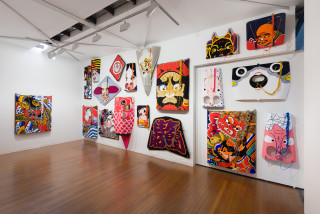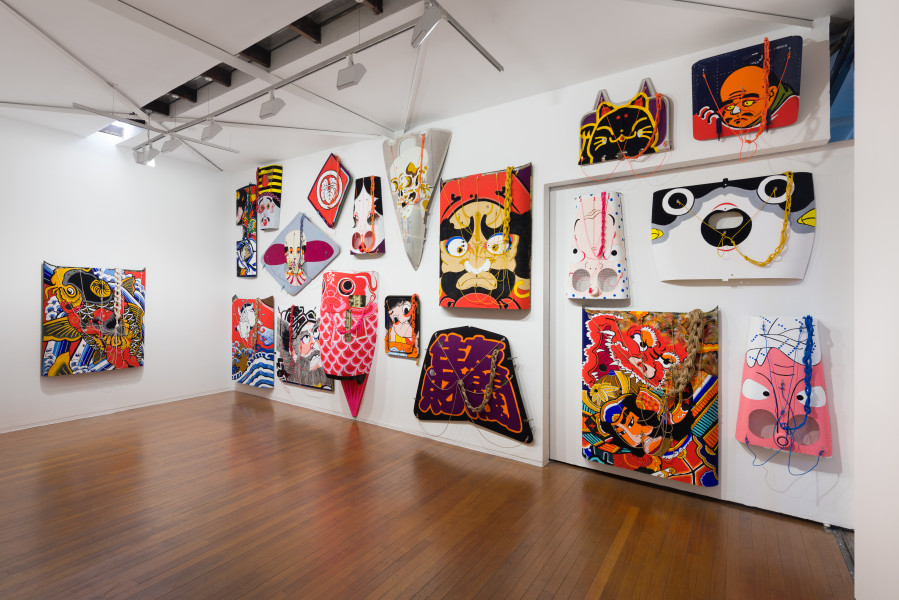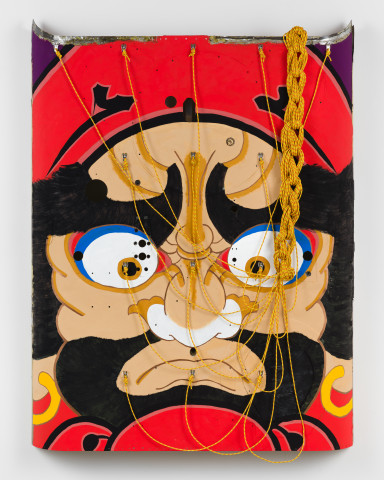We have reversed the evolution of manned flight by taking Australian Air Force surplus plane parts and with a bit of paint and string, turned them back into kites. Japanese kites are not representative of a culturally hermetic system and are therefore a great visual example of transculturation. Our aim is to re-focus on the here and now without suffering from cultural myopia.
—Claire Healy and Sean Cordeiro
Exhibition Dates: 3 December 2020 – 23 January 2021
With tuppence for paper and strings
You can have your own set of wings
With your feet on the ground
You're a bird in a flight
With your fist holding tight
To the string of your kite
—Mary Poppins, 1964
The onanistic nature of kite flying transcends cultures. In English, the phrase “Go fly a kite” is an old timey way of saying “Go fuck yourself” while in Thai, "chák wâao" (lit. pull kite) is a term for male masturbation.
Is it the combination of daydreaming and dexterity that gives kite flying such a reputation? If so, the act of painting could be said to evoke the same feelings. Our new body of work You Are Here is a meditation on kite flying via painting. It is part of a new 2020 art movement, joining the pandemic lexicon together with iso haircut; iso fashion; iso bubble - iso art: art created when you have time on your hands and nowhere to go.
The question that kicked off our line of enquiry is: what’s the difference between a kite and an airplane?
Kites and planes come from the same family but the philosophy behind flying kites and planes are quite different. A kite is a flying object that inspires daydreams while locating you within a specific time and place. Like a pin stuck in a map, the tethered kite marks us within the here and now. Conversely, an airplane makes the drive to be somewhere else entirely, a possible reality.
We have reversed the evolution of manned flight by taking Australian Air Force surplus plane parts and with a bit of paint and string, turned them back into kites. We have used traditional Japanese kite designs because a) they look really awesome and b) Japanese kites are not representative of a culturally hermetic system1 and are therefore a great visual example of transculturation. Our aim is to re-focus on the here and now without suffering from cultural myopia.
Japanese kite designs have been appropriated to create a body of work that is indicative of our own personal experience of the COVID-times. The cessation of international flight cancelled our planned artist residency in Niigata. This residency was to be a period of research and connecting with the giant kite flying community of Shirone. Since we were grounded in Australia, 2020 was spent in our studio, daydreaming about kites. This body of work is indicative of the iso-Age, a time when we had a surfeit of global online knowledge at our fingertips but were unable to physically travel anywhere.
This tension between being stuck somewhere and wanting to be somewhere else is strangely reminiscent of those early adolescent years trapped in the ‘burbs: those years of feeling that somewhere, elsewhere, something interesting was happening - it just wasn't where you were... Conversely, this informed dislocation can inspire a punk DIY attitude of making your own fun regardless of skill-level: bands are formed, low-budget films are made and painfully earnest art is produced. This kind of isolation can also lead to The Pizza Effect2.
Thus 2020 found us teaching ourselves Japanese kite painting. Much in the same way that Eiji Tsuburaya created Godzilla after watching King Kong3, we practiced in isolation to emulate an aesthetic, and through doing so, acted out a philosophy. Without getting too 90s nostalgic, our act of re-painting warplanes was a kind of reclamation of the kite.
Why would anyone want to reclaim a kite? And what does reclaiming a kite actually entail? And most of all, what does it mean?!? Our reclamation of the kite is a notional de-militarisation of the flying machine. It is not commonly known that it only took six years after the Wright Brothers’ first successful powered-flight in 1903 for that technology to be sold by the Brothers to the American Military. It was an act that was anathema to their Australian predecessor Lawrence Hargrave. Hargrave believed that flight belonged to mankind as a whole. It was not the first time that an object of marvel was repurposed into a tool of war. The transformation of fireworks into deadly weapons is a process that took place at the beginning of the first millennium CE.
Put simply, we have used the 20th century militarisation of the kite as a metaphor for the 21st century weaponisation of social media. The transformation of an object of entertainment to a tool of subjugation is a process that has played out before our eyes. The tools that facilitated the Arab Spring of 2010 have now given birth to anti-vaxxers, QAnon, flat-earth theorists, birthers, climate-change deniers, coronavirus sceptics and satire-proof Presidents. The human urge to be LikedTM has broken the Wisdom of Crowds, which has been used by state and non-state actors to breed extremist views in individuals in order to foment chaos.
It seems that if religion is the opiate of the masses then social media has become our Fentanyl. Our addiction to a socially mediated reality draws us out of the here-and-now and places us in a seemingly consequence-free virtual world. Re-painting warplanes is our quiet call to re-focus our technologies and awareness back to creative daydreams and away from the trollish nightmares: to reclaim our space of contemplation as extolled by Henry David Thoreau, “improve the nick of time… stand on the meeting of two eternities, the past and future, which is precisely the present moment; to toe that line.”
It is that grounded line, the line of the kite that we have explored through our foray into traditional kite painting, marking our location in space and time: You are here. An encouragement to locate ourselves in the here and now while exhorting us: Let’s go fly a kite!
—
1 Chinese Buddhist missionaries introduced kites to Japan during the Nara period (710-794 AD).
2 The Pizza Effect is the phenomenon of elements of a nation or people's culture being transformed or at least more fully embraced elsewhere, then re-imported to their culture of origin, or the way in which a community's self-understanding is influenced by (or imposed by, or imported from) foreign sources.
3 Tsurubaya obtained a 35mm print of King Kong and in his free time studied the visual effects frame-by-frame, deducing how each visual effect was created without any manual or journal.
 Claire Healy and Sean Cordeiro You Are Here
Claire Healy and Sean Cordeiro You Are Here
Roslyn Oxley9 Gallery, 2020-21
 Claire Healy and Sean Cordeiro Tower of Power
Claire Healy and Sean Cordeiro Tower of Power
Sydney Contemporary, Carriageworks, 2019
 Group Show, Caught Stealing
Group Show, Caught Stealing
National Art School, Sydney, 2019
 Group Show, The Like Button
Group Show, The Like Button
Roslyn Oxley9 Gallery, 2018-19
 Claire Healy and Sean Cordeiro The Pizza Effect
Claire Healy and Sean Cordeiro The Pizza Effect
Tenjinyama Artist Studios, Sapporo, 2018
 Claire Healy and Sean Cordeiro Cloud Nation
Claire Healy and Sean Cordeiro Cloud Nation
Green Square Library, Sydney, 2018
 Divided Worlds
Divided Worlds
Adelaide Biennial of Australian Art, 2018
 Claire Healy and Sean Cordeiro The Ugly Stick Orchestra
Claire Healy and Sean Cordeiro The Ugly Stick Orchestra
Roslyn Oxley9 Gallery, 2017
 Claire Healy and Sean Cordeiro Effing The Ineffable
Claire Healy and Sean Cordeiro Effing The Ineffable
Chan + Hori Contemporary, Singapore, 2016
 Claire Healy and Sean Cordeiro Reader's Digest
Claire Healy and Sean Cordeiro Reader's Digest
QT Hotel, Melbourne, 2016-17
 Claire Healy and Sean Cordeiro Banana Republic
Claire Healy and Sean Cordeiro Banana Republic
Barangaroo Sculpture Walk, Sydney, 2016
 Claire Healy and Sean Cordeiro We Hunt Mammoth
Claire Healy and Sean Cordeiro We Hunt Mammoth
Yorii-za Theatre, Kamiyama, Japan, 2015
 Group Show, People Like Us
Group Show, People Like Us
University of New South Wales Galleries, Sydney, 2015
 Claire Healy and Sean Cordeiro Venereal Architecture
Claire Healy and Sean Cordeiro Venereal Architecture
Roslyn Oxley9 Gallery, 2014
Claire Healy and Sean Cordeiro
Museum of Contemporary Art Australia, Sydney, 2012
Claire Healy and Sean Cordeiro Drunken Clarity
Gallery Barry Keldoulis, Sydney, 2011
Claire Healy and Sean Cordeiro Par Avion
Frey Norris Gallery, San Francisco, 2011
Group Show, Future Furnishing
Nature Morte Gallery, Berlin, 2011
Claire Healy and Sean Cordeiro Are We There Yet?
Corcoran Gallery of Art, Washington DC, 2011
 Claire Healy and Sean Cordeiro Life Span
Claire Healy and Sean Cordeiro Life Span
53rd Venice Biennale, 2009
Claire Healy and Sean Cordeiro PREMS
La Bf15, Lyon, 2009
Claire Healy and Sean Cordeiro Disruptive Colouration
Gallery Barry Keldoulis, Sydney, 2008
 Group Show, Contemporary Australia: Optimism
Group Show, Contemporary Australia: Optimism
Gallery Of Modern Art, Brisbane, 2008
Claire Healy and Sean Cordeiro Absent Referent
Stanley Picker Gallery, London, 2008
Group Show, Dry Rot
Galerie Alexandra Saheb, Berlin, 2008
Group Show, Golden Mean
Casula Powerhouse, Sydney, 2008
Claire Healy and Sean Cordeiro Paper Trail
Art Gallery of New South Wales, Sydney, 2007
Claire Healy and Sean Cordeiro Primary Producers
Performance Space, Carriageworks, Sydney, 2007
Group Show, Ten[d]ancy
Elizabeth Bay House, Sydney, 2006
Claire Healy and Sean Cordeiro Flat Pack
Künstlerhaus Bethanien, Berlin, 2006
Group Show, Adventures with Form in Space
Art Gallery Of New South Wales, Sydney, 2006
Group Show, Custom Living
Gallery Barry Keldoulis, Sydney, 2006
Group Show, When the Bulls Fight the Calves get Crushed
Siddhartha Gallery, Kathmandu, Nepal, 2005
Group Show, From Space to Place
IASKA, Kellerberrin, WA, 2004
Claire Healy and Sean Cordeiro Deceased Estate
Glashaus Gallery, Weil am Rhein, Germany, 2004
Claire Healy and Sean Cordeiro Package Tour
Sculpture By The Sea, Sydney, 2003
Claire Healy and Sean Cordeiro The Cordial Home Project
Artspace, Sydney, 2003























